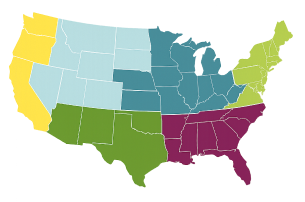What Are The Easiest Wildflowers To Grow?
- Cosmos: These unfussy blooms grow almost anywhere with a burst of color.
- Zinnias: Strong, colorful, and perfect for a summer pollinator show.
- California Poppies: Bright and breezy—just toss the seeds and watch them flourish!
- Blue Cornflowers: Known for their striking blue hue, they’re easygoing and hardy.
- Why they're great: These wildflowers grow quickly, adapt to different climates, and require very little care—ideal for a stress-free garden.
What Is The Best Time To Plant Easy-To-Grow Wildflower Seeds?
Areas With Freezing Winters | Generally Zones 1-6
(Northeast, Midwest, and The Rockies)
- Fall Dormant Seeding: Dormant seeding is recommended in late fall (November-December), after the ground begins to freeze but before heavy snow cover. This allows seeds to naturally overwinter.
- Spring: Plant easy-to-grow wildflower seeds in early spring (April-May) when the soil has thawed and temperatures are consistently warming up.
- Summer: Most wildflower seeds can be planted in late summer (August-September) if you avoid the heat and water well during establishment.
Temperate Climates | Generally Zones 7-10(Much of the Southeast and Southwest)
- Fall: Planting in fall (October-November) works well to establish the plants during the cooler months.
- Spring: The ideal time is early spring (March-April) when the weather is still cool but frost risks have passed.
- Summer: Plant easy-to-grow wildflower seeds in late summer (August-September) with extra care to avoid extreme heat and ensure proper irrigation.
Areas with No Winter Freeze | Zones 11+(Southern Florida/Texas/California, Southwest)
- Fall: Fall planting (October-November) is ideal to give seeds time to settle before any cooler temperatures set in.
- Spring: The best time to plant easy-to-grow wildflowers is early spring (February-March), just before the heat of summer.
- Summer: In summer, plant easy-to-grow wildflowers in late summer (August-September) with proper watering and care to help them establish.
How Long Does It Take For Wildflower Seeds To Bloom?
- Fast bloomers: Many easy-growing annuals, like Cosmos and Zinnias, will reward you with blooms in just 6 to 8 weeks. As annuals, they bloom for one glorious season, then make way for new plantings.
- Perennials:Like Black-Eyed Susans and Blanket Flowers, perennial wildflowers take their time, often blooming in the second year and coming back year after year. They’ll provide long-lasting beauty and pollinator support for years to come.
How Do I Know Which Wildflower Mix Is Right For My Garden?
- Tailored Options: We offer a variety of wildflower seeds tailored to different conditions, such as full sun, partial shade, or specific colors like blue wildflowers, pink wildflowers, and purple wildflowers. Use our shopping filters to find the mix that best matches your garden’s conditions.
- Need Help? If you’re unsure, our team is ready to help you choose the perfect mix.
Are Wildflowers Good For Pollinators?
- Yes! Easy-to-grow wildflowers are the perfect way to support local pollinators like bees, butterflies, and hummingbirds.
- Top pollinator picks: Flowers like Red Poppies, Echinacea, and Sunflowers attract pollinators and encourage biodiversity in your garden, helping nature thrive. Our exclusive wildflower seed mixes, like our Mini Meadows Wildflower Seed Mix, are also comprised of easy-to-grow wildflowers, ensuring pollinator-supporting flowers throughout the entire growing season.

